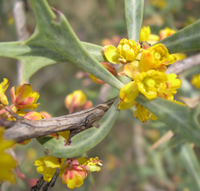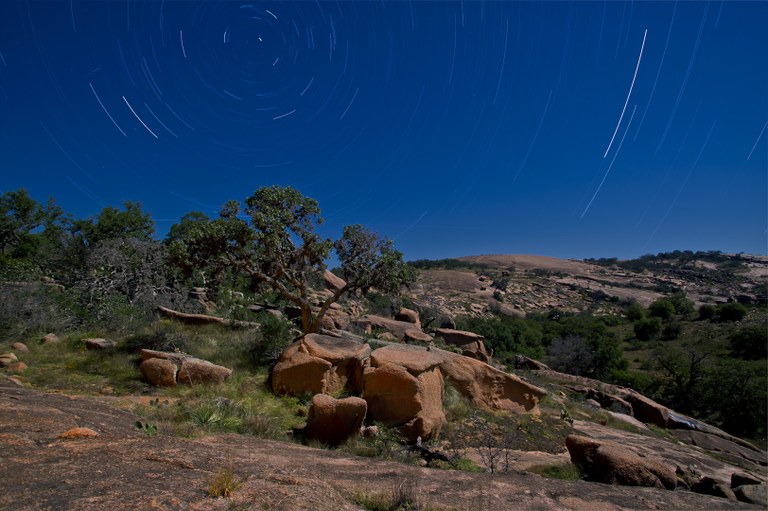Nature
Geology
Why is this giant dome here?
One billion years ago, this granite was part of a large pool of magma, or hot liquid rock, perhaps seven miles below the earth’s surface. It pushed up into the rock above in places, then cooled and hardened very slowly, turning into granite. Over time, the surface rock and soil wore away.
Stars over Enchanted Rock.
Learn about stargazing at this International Dark Sky Park.
Those pushed-up areas are the domes you see in the park: Enchanted Rock, Little Dome, Turkey Peak and others.
Although Enchanted Rock appears to be solid and durable, it continues to change and erode.
Enchanted Rock is an exfoliation dome (as are the other domes here). That means it has layers like an onion.
After the rock and soil on top wore away, the granite expanded slightly because there was less weight bearing down on it. That expansion caused the dome to split into curved sections. As the outer layer of rock breaks into smaller pieces and slides off, the next layer begins to peel away from the dome. This is a process that continues today.
Enchanted Rock rises 425 feet above the base elevation of the park. Its high point is 1,825 feet above sea level, and the entire dome covers 640 acres. Climbing the Rock is like climbing the stairs of a 30- or 40-story building.
Vernal Pools
On more level portions of the dome, water collects in low spots, or weathering pits. The granite in these pits wears away faster than the surrounding granite. Pits that hold water for several weeks are called vernal pools. Over time, these pools develop into microhabitats, home to a unique group of plants and animals.
The pools are very fragile. Enjoy them from a distance. Protect this special habitat by keeping pets and people out.
Animals
At Enchanted Rock, you will see the usual animals found in Central Texas. Rock and fox squirrels are common, as are armadillos, rabbits and other small animals. You can frequently see white-tailed deer.
Look for lizards and vultures on and above the Rock year-round.
Birders will find varied and abundant species. Ask for a bird checklist at park headquarters.
Fairy Shrimp
Tiny, translucent freshwater shrimp live in the vernal pools. These little fellows lay eggs which somehow survive the dry season. The eggs hatch when the pools refill with rainwater. The shrimp swim upside down, eating algae and plankton. In turn, they are eaten by birds, providing an important link in the food chain. These creatures are an integral part of the fragile vernal pool habitat.
Find more information on the animals of Enchanted Rock State Natural Area:
- Texas Wildlife Fact Sheets
- Butterflies and Moths of Gillespie County
- Just for Kids: Garbage Getters
- Keep Texas Wild: Edwards Plateau (YouTube video)

- Agarita
Plants
Four major plant communities grow in the park:
- Open oak woodland is studded with post, live and blackjack oaks, with black hickory in moister areas. Texas persimmon, agarita, whitebrush and prickly pear shrubs grow beside the oaks. Bluestem, three-awn and grama grass thrive in the shade of the oaks, while American tripogon grows on gravel slopes.
- Mesquite grassland is covered with three-awn, grama, Texas wintergrass, panicum and sandbur grass, along with the invading mesquite trees.
- Floodplain has a different mix of trees: elm, pecan, hackberry, black hickory, soapberry and oak. Shrubs such as white buckeye, agarita, Texas persimmon, Roosevelt weed and buttonbush grow here. Grasses and sedges, along with annual and perennial herbs, cover the ground. These include winter and water bentgrass, several Eupatorium species, Indiangrass, bushy bluestem, Georgia frostweed and switchgrass. Wildflowers such as bluebonnets, Indian paintbrush, coreopsis, bladderpod and basin bellflower bloom in the spring.
- Granite rock

- Gayfeather. Flower photos by Bill Lindemann.
Lichens
As you walk the trail, you may notice gray, black, green and orange patches growing flat on the rocks. These are lichen. Lichen is not a single plant, but two separate organisms, a fungus and a green alga, growing together. Living conditions on bare rock are harsh. But together, these two can survive. Lichens grow very slowly; a four-inch patch of gray shield-lichen could be a thousand years old!
Rock Quillwort
Rock quillwort looks like a very short, thin-leaved, pale green grass growing in the vernal pools. It sticks out of the water about .5 to 2 inches at most. It does not bloom, but reproduces from spores. This small, endangered plant grows only in Central Texas, in the fragile environment of the vernal pools.
Find more information on the plants of Enchanted Rock State Natural Area:
- Interpretive Trail Guide
- Plants of the Edwards Plateau
- To look up an unknown plant, try the Wildflower Center Native Plant Database.
Protect our Park
You, and all the visitors at Enchanted Rock State Natural Area, hold the fate of this spectacular resource in your hands.
Because so many people hike here, erosion and soil compaction threaten the plants along sections of the summit trail. People and pets can cause serious damage to the vernal pools.
You can help protect this park by making sure you and your family stay on trails and out of the vernal pools.

